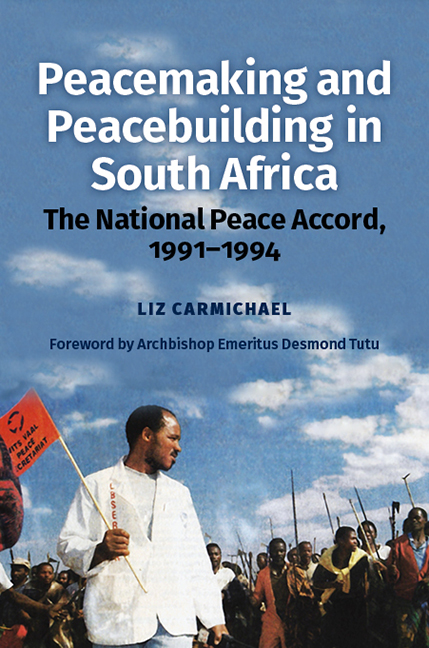Book contents
- Frontmatter
- Dedication
- Contents
- List of Illustrations
- List of Abbreviations
- Glossary
- Acknowledgements
- Note on Nomenclature
- Transition Timeline
- Foreword
- Introduction
- Part One Peacemaking, Peacebuilding, and the South African Conflict
- Part Two Peacemaking
- Part Three Peacebuilding
- Conclusion: Impact and Unfinished Business
- Bibliography
- Index
7 - Convening the Parties
Published online by Cambridge University Press: 08 October 2022
- Frontmatter
- Dedication
- Contents
- List of Illustrations
- List of Abbreviations
- Glossary
- Acknowledgements
- Note on Nomenclature
- Transition Timeline
- Foreword
- Introduction
- Part One Peacemaking, Peacebuilding, and the South African Conflict
- Part Two Peacemaking
- Part Three Peacebuilding
- Conclusion: Impact and Unfinished Business
- Bibliography
- Index
Summary
Introduction
Church and business could now form a convening group, mandated by government and the ANC-Alliance and reluctantly endorsed by Buthelezi. It successfully called and facilitated a ‘planning meeting’ representative of the whole spectrum of political parties and organizations except the far right, on 22 June 1991. The meeting agreed the issues to be addressed to combat violence, and appointed a Preparatory Committee to take the process forward.
Forming the ‘Facilitating Committee’
Two days after the Summit, on Monday 27 May, Louw Alberts, Frank Chikane, Johan Heyns, Ray McCauley and Ron Steele met at the SACC. Alberts explained his brief from the President, and asked all to play whatever role might be requested with ‘quiet consultation and confidentiality’ (Steele, 1992 p.155). They agreed to draw in others from church and business and meet as a facilitating group on Tuesday 4 June.
Suddenly, with the Rustenburg Committee in the news, Buthelezi granted it an audience. The Rhema Church chartered a plane and, early on 3 June, Alberts, Chikane, Heyns, McCauley, Steele and three others arrived in Ulundi. Disappointingly, Buthelezi spent the morning in the Legislature, leaving them to discuss the Rustenburg Declaration with the IFP's irenic national Chairman, Dr Frank Mdlalose, and other officials who gave them a grilling, dwelling on past resentments and treating the Committee as merely an extension of the despised SACC.
Buthelezi joined them for lunch. A cautiously positive joint statement emerged: ‘In the light of the open communication which took place, the meeting we believe, will probably have given momentum to our respective involvement in the peace process.’ Points for further discussion had been noted, including ‘more factors regarding the violence’ which were not been addressed by the Rustenburg Declaration, of which future peace initiatives ‘would have to take due cognisance’.
Steele (1992 p.157) felt the day was ‘a clear warning sign that any future peace negotiations or constitutional talks were going to be arduous and exhausting’. They flew back into a ‘fiery sunset’, vowing to continue and realizing the alliance with business would be vital.
The following afternoon, Tuesday 4 June, saw the first meeting of the ‘Facilitating Committee’: eleven members gathered for several hours in the Carlton Hotel's Town Room.
- Type
- Chapter
- Information
- Peacemaking and Peacebuilding in South AfricaThe National Peace Accord, 1991-1994, pp. 111 - 123Publisher: Boydell & BrewerPrint publication year: 2022

